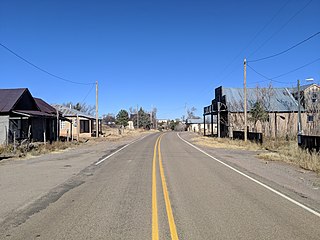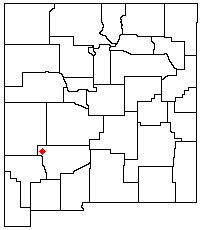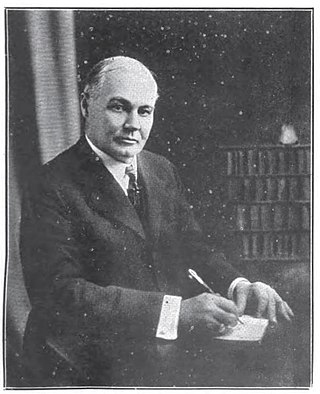Related Research Articles

Rio Arriba County is a county in the U.S. state of New Mexico. As of the 2020 census, the population was 40,363. Its county seat is Tierra Amarilla. Its northern border is the Colorado state line.

Torreon is a farming community and census-designated place (CDP) in Torrance County, New Mexico, United States. The population was 244 at the 2000 census. It is part of the Albuquerque Metropolitan Statistical Area.

The official flag of New Mexico consists of a red sun symbol of the Zia people on a field of gold (yellow). It was officially adopted in 1925 to highlight the state's Native American and Hispano heritage: It combines a symbol of the Puebloan people, who have ancient roots in the state, with the colors of the flag of Spain, which established and ruled Nuevo México for over two and a half centuries.

Albert Bacon Fall was a United States senator from New Mexico and Secretary of the Interior under President Warren G. Harding who became infamous for his involvement in the Teapot Dome scandal; he was the only person convicted as a result of the affair. As a captain in the United States Army, he supported a military invasion of Mexico in 1916 as a means of ending Pancho Villa's raids.

Arthur Thomas Hannett was an American lawyer and politician who rose to become the seventh governor of New Mexico.
Frank Willey Clancy was Attorney General of New Mexico (1909–1916), as well as Mayor of Albuquerque (1898).

The Black Range is an igneous mountain range running north–south in Sierra, Grant, and Catron counties in southwest New Mexico, in the Southwestern United States.

The 1912–13 United States Senate elections were held on various dates in various states. They were the last U.S. Senate elections before the ratification of the Seventeenth Amendment in 1913, establishing direct elections for all Senate seats. Senators had been primarily chosen by state legislatures. Senators were elected over a wide range of time throughout 1912 and 1913, and a seat may have been filled months late or remained vacant due to legislative deadlock. Some states elected their senators directly even before passage of Seventeenth Amendment. Oregon pioneered direct election and experimented with different measures over several years until it succeeded in 1907. Soon after, Nebraska followed suit and laid the foundation for other states to adopt measures reflecting the people's will. By 1912, as many as 29 states elected senators either as nominees of their party's primary or in conjunction with a general election.

William Joseph Mills was an American jurist who served three terms as the chief justice of the New Mexico Territorial Supreme Court and as the nineteenth and final Governor of New Mexico Territory.
Harry Pye was a prospector and sometime mule skinner in New Mexico Territory who discovered silver chloride in the Black Range in 1879 initiating a multimillion-dollar silver rush.

José Francisco Chaves was a nineteenth-century military leader, politician, lawyer and rancher from the New Mexico Territory.

Merritt Cramer Mechem was an American politician who served as territorial Supreme Court justice and fifth governor of New Mexico.

Miami is an unincorporated community in Colfax County, New Mexico, United States.
Edward W. B. Newby (1804–1870) American soldier, a colonel of volunteers in the Mexican–American War, a captain of cavalry in the early campaigns of the American Indian Wars in the west and a major in the American Civil War.

Ralph Emerson Twitchell (1859–1925) was an American attorney, historian, and politician who served as the mayor of Santa Fe, New Mexico and chairman of the Rio Grande Commission, which drafted a treaty between the United States and Mexico leading to the building of the Elephant Butte Dam. Twitchell helped organize the first National Irrigation Congress in 1891. He is credited with rescuing the Spanish Archives from the territorial capitol building when it caught fire on May 12, 1892, and also designing the first Flag of New Mexico in 1915.
Bartolomé Baca was Governor of the territory of Santa Fe de Nuevo México from August 1823 until September 1825. His very large landholdings were later the subject of disputes that eventually went to the Supreme Court of the United States.
Abraham Lincoln Zinn was an American attorney and jurist who served as a justice of the New Mexico Supreme Court from January 1, 1933 to May 31, 1943.
Joe L. Martínez was Attorney General of New Mexico from 1949 to 1952, and a justice of the New Mexico Supreme Court from January 1, 1973, until his resignation on July 23, 1975.

The Grand Lodge of Ancient, Free And Accepted Masons of New Mexico is the oldest and largest of the two regular Masonic Grand Lodges in the State of New Mexico. It was founded on August 7, 1877, in Santa Fe, New Mexico.
Pete Burleson was a cattle drover and rancher, western lawman, farmer and pioneer in the New Mexico Territory and State of New Mexico. He drove cattle from Texas as part of the 1870's I. W. Lacy - L. G. Coleman cattle drive, settling in northeast New Mexico as a cattle rancher near Cimarron. He was elected sheriff of Colfax County (1877–1871), serving in this capacity during the bloodiest part of the Colfax County War (1873–1888). In his tenure as sheriff and as a resident of Cimarron, he was close friends with several notorious cowboys including Clay Allison and David John (Davy) Crockett. Burleson was also a deputy sheriff in Colfax County and Lincoln County for seven different sheriffs, his last appointment coming at age 63. Western writers Eugene Manlove Rhodes and Emerson Hough both included characters in their novels and short stories based on Burleson.
References
- Obituary: Staff (1932) "S. Burkhart, Ex-U.S. Attorney Here, Dies at 73; Ill Three Months" Albuquerque Journal 15 May 1932, page 1, column 3
- Short biography: Twitchell, Ralph Emerson (1911) The Leading Facts of New Mexican History, Volume V Torch Press, Cedar Rapids, Iowa, p. 122, OCLC 3828708